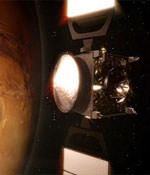
Image credit: ESA
On January 7 and for the following three days, Mars Express will attempt to communicate with the missing Beagle 2 lander. Now that it’s modified its orbit, Mars Express will pass directly over the region that Beagle 2 was thought to have landed. Previous attempts to reach the lander have been unsuccessful; however, Mars Express and Beagle 2 have been extensively tested to communicate with one another. The first attempt will happen on January 7 at 1215 UTC (7:15 pm EST January 6). The European Space Agency will announce their results a few hours later.
As of Wednesday 7 January 2004, and for the following three days, ESA?s Mars Express orbiter will be as little as 315 kilometres above the landing area of the still-silent Beagle 2.
Since Christmas attempts to communicate with the tiny lander through NASA?s Mars Odyssey orbiter and radio telescopes on Earth have been unsuccessful. However, Mars Express and Beagle 2 are the only systems tested end-to-end, giving ESA more confidence of establishing contact with the lander in the coming days.
The Ultra High Frequency (UHF) receivers on Mars Express are ready to communicate with Beagle 2. On 7 January, at precisely 13:15 CET, ESA?s Mars Express orbiter will be in both an ideal flight path and an ideal communication configuration, right over the Beagle 2 landing area, at about 86 degrees, allowing ground controllers at ESA?s European Space Operations Centre (ESOC) in Darmstadt, Germany, to catch the slightest beep from the Martian surface.
The results of this first search attempt will be announced at a press briefing at ESA/ESOC by David Southwood, Director of Science, Rudolf Schmidt, Mars Express Project Manager, and Michael McKay, Deputy Flight Director, starting at 16:00 CET.
Original Source: ESA News Release
